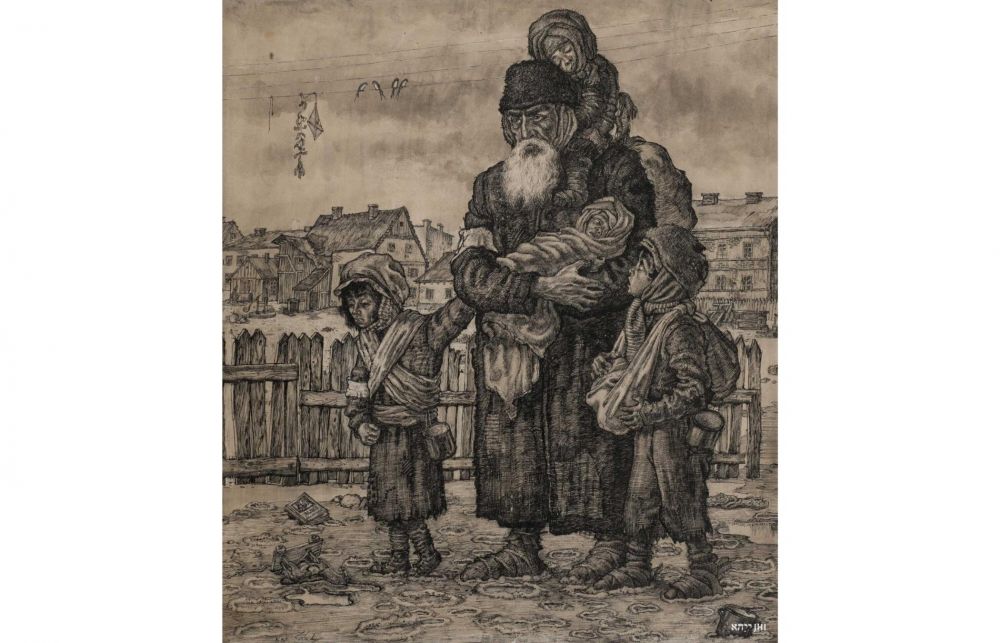- News
- Events
- Oneg Shabbat
- Collections
- Research
- Exhibitions
- Education
- Publishing Department
- Genealogy
- About the Institute
- Bookstore


Zdzisław Lachur, Jewish family in the Warsaw Ghetto, June 1952, JHI collection
There was a well-known family from Łódź, initially consisting of eight people. All their property was two strollers, on one of them he carried three children, and she carried two on the other. They pushed the strollers down the street and sang old Jewish songs. They had very nice voices. She sang and he sang, six children's chants followed them, then there were four, then there were three and one stroller disappeared and the shoes and the remnants of the outer garments disappeared. Recently, the family consisted of two people and one stroller. He and she lying on a stroller. She was 39 years old and looked as if she was 100 years old, lying in a pram and singing along with her husband. They sang the same songs, they got the same pennies as last year.
The second known type that stood out from the gray mass of those dying in front of the tenement houses was Nuchem Lejbkorn. Before the war, he owned a house, he had a shop in Skierniewice, a wife and five children. The Germans deported him to Warsaw.
![kramsztyk_lejbhorn_zw_1.jpg [488.16 KB]](https://www.jhi.pl/storage/image/core_files/2022/7/11/599eb0688836cff1724c2de40bfa0916/jpg/jhi/preview/kramsztyk_lejbhorn_zw_1.jpg)
In a few months he became a pauper. Wife died of typhus. The oldest child died that same week. Lejbkorn moved from the lodger’s room to the point [refugee shelter], and from there to the street. They walked the streets of the ghetto. Three of the children clung to the remnants of his clothes, and the fourth he carried high on his shoulders. They walked and sang only one Jewish song: "Ich dank dir Got, az ich bin a id" [Thank You God that I'm a Jew].
Then the children died of starvation. And he was still strong, he was still walking, though his legs were already swollen. Autumn came, and he was still walking, then winter, he was already without shoes, without clothes. He still had a quilt in which he was tied with ropes, with his hands inside. From the bottom of the quilt, horribly swollen legs protruded, from above a small, dry face covered with yellow skin and framed with a pointy goatee. Feathers spilled from the quilt. Passers-by made a wide passage for him on the always crowded streets. This and that threw a few pennies into a can placed on ropes, and Lejbkorn walked in the middle of the crowd, content, with an idiot’s or a sage’s smile, and always sang the song “Ich dank dir Got, az ich bin a id”.
Or another idiot singing a song with only two words, "I'm hungry." He sang these two words to the waltz and foxtrot melody – he could not sing, but he danced to the beat and kept repeating the two words "I'm hungry". [The image] was completed by those lying by the walls, whose weak voices did not reach the ears of passers-by, but they hurt the eyes of the sensitive with the enormity of their terrible poverty.
But the king of Warsaw beggars, "Ałe glajch" [Everyone’s equal], was sated and cheerful, he made a career. He had his ideas, he knew how to dress, he was still a new and welcome [attraction] for onlookers. He appeared on the street in various costumes, explaining the reasons with jokes, and these jokes would be repeated by everyone. Is he wearing a lady's dress? Cause I don't have a wife, today I'm my wife, okay? He put on bathing shorts and said he was walking on the beach, okay? He's been wearing a tailcoat for a few days, because he attends a meeting of the commune or the provisioning department, okay? He was so popular that the management of "Melody Palace" [premises at 12 Rymarska Street – ed.] organized a revue entitled "Ałe glajch". The role of Rubinsztejn was played by Minowicz. And in the finale, the most popular ghetto madman, dressed in a tailcoat, appeared in person (…).[1]
The circumstances of Lejbkorn's death are not exactly known.
A family of five in the Warsaw ghetto was drawn by Roman Kramsztyk (drawing in sanguine) before his death during the great deportation in August 1942. After the war, the family was also drawn by Zdzisław Lachur (pen drawing).
Footnote:
[1] Z pamiętnika Samuela Putermana [From Samuel Puterman’s diary] in: Pamiętniki z getta warszawskiego. Fragmenty i regesty [Diaries from the Warsaw Ghetto. Fragments and regests], ed. Michał Grynberg, Warsaw 1993, p. 33-34.
_____
![2022_marsz_pamięci_tło_EN_JPG.jpg [488.95 KB]](https://www.jhi.pl/storage/image/core_files/2022/7/7/b284ac003c5dd9bc5eb239928ecf6a17/jpg/jhi/preview/2022_marsz_pamięci_tło_EN_JPG.jpg)
Eighty years ago, the Jewish community of Warsaw almost completely ceased to exist. In the summer of 1942, the Germans deported nearly 300,000 Jews to the Treblinka death camp. We invite you to participate in the annual March of Remembrance, commemorating the murdered inhabitants of the Warsaw Ghetto.
From July 22 to September 21, 1942, from Umschlagplatz – the square at Stawki Street from which transportations to the gas chambers took place – as well as on the overcrowded trains going to the camp, and in Treblinka itself, nearly 300,000 Jews were murdered.
We will remember, in a special way, the Jewish refugees and deportees from cities and towns in occupied Poland and Europe, who died in the Warsaw Ghetto due to hunger and disease, or were killed in Treblinka in the summer of 1942.